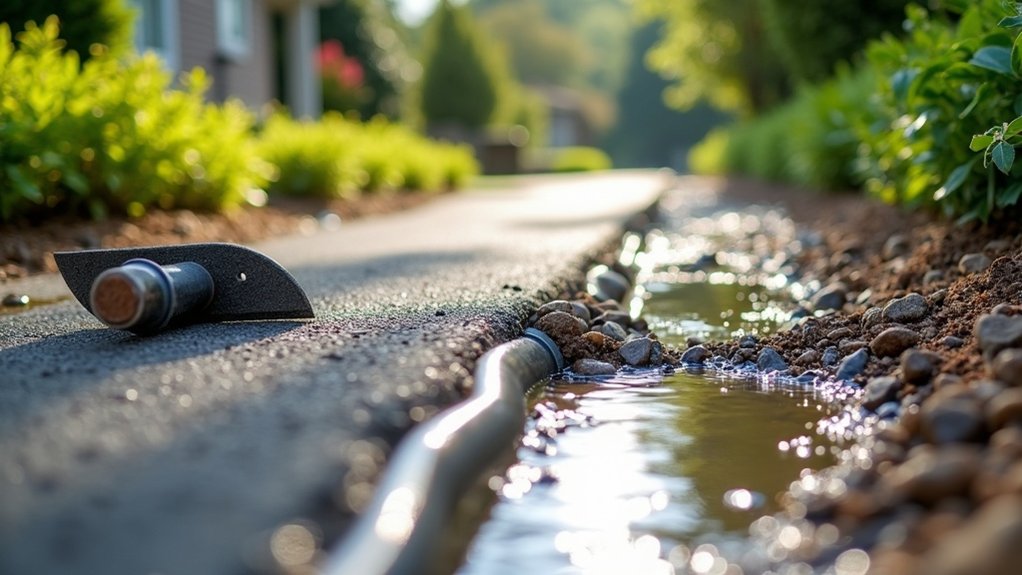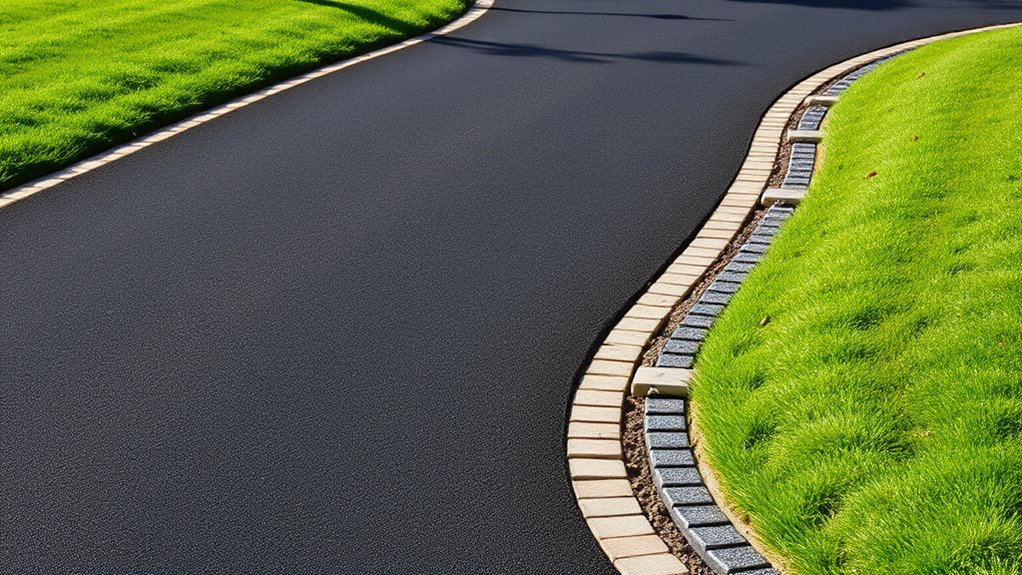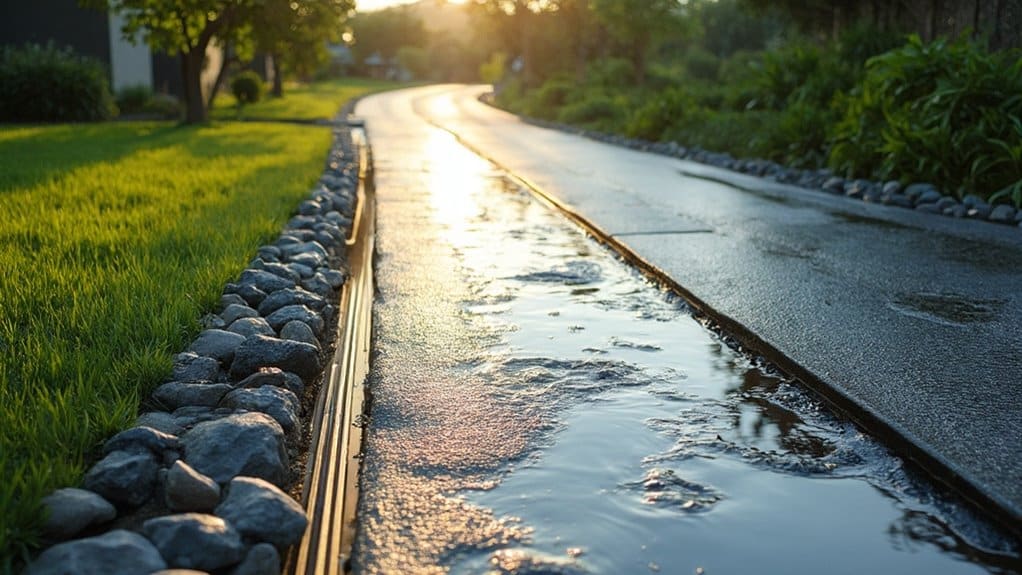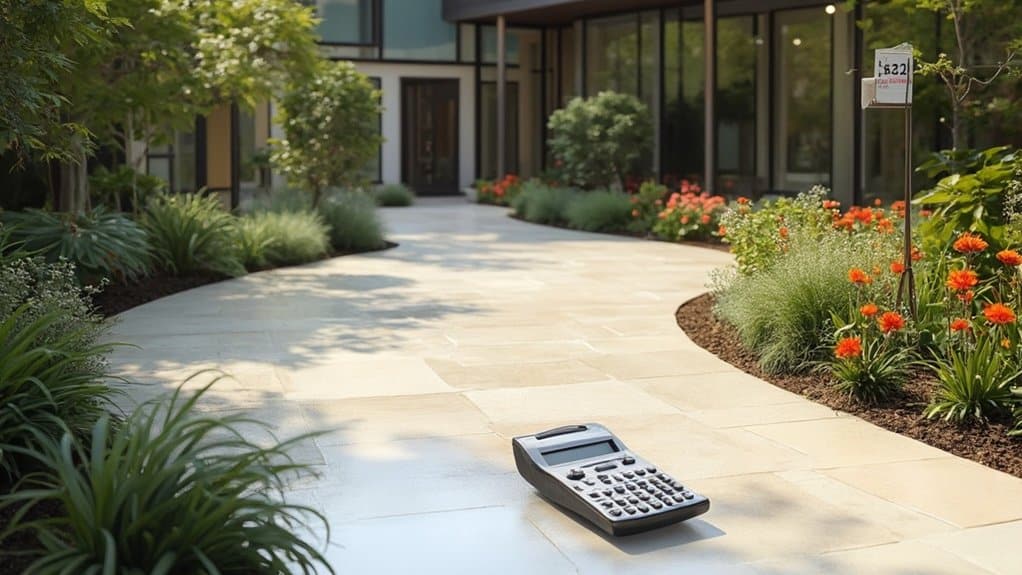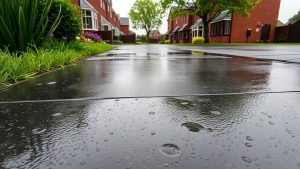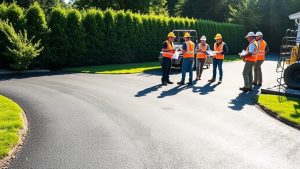To resolve drainage issues on your resin driveway, begin by ensuring a minimum slope of 1% to facilitate proper water runoff. Look out for common problems such as inadequate sub-base material and blocked surface pores. Regular maintenance, including sweeping and washing down the surface, can prevent drainage complications. Opt for MOT Type 3 aggregates for improved permeability and enhance your drainage systems where necessary. By addressing these elements, you can manage water effectively and avoid expensive repairs down the line. Consider exploring additional solutions for long-lasting results.
Table of Contents
ToggleKey Takeaways
- Check the slope of your driveway; aim for a minimum gradient of 1% to ensure water flows away and doesn’t pool.
- Regularly inspect and clean any clogged surface pores to keep drainage working efficiently and avoid long-term problems.
- Make sure you have enough sub-base material; using MOT Type 3 is a good choice as it allows for better permeability and water flow.
- Look out for signs of water damage, such as persistent puddles or cracks, as these can indicate drainage issues that need addressing sooner rather than later.
- Consider adding drainage channels and adjusting the gradients to guide runoff towards drains or soakaways, improving water management overall.
Understanding the Importance of Drainage in Resin Driveways
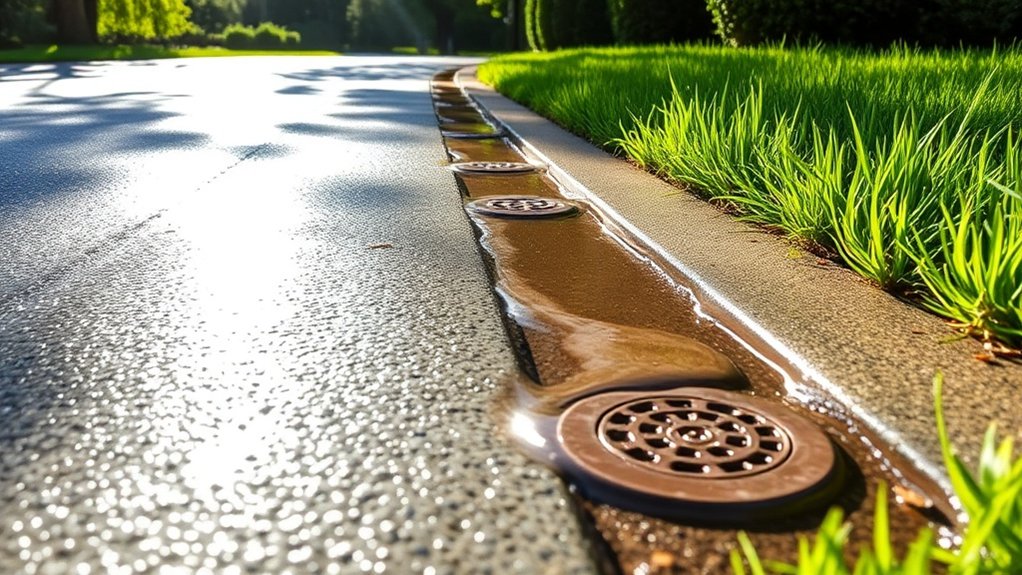
When installing a resin driveway, it’s vital to understand the importance of drainage for long-term functionality and safety. Proper drainage prevents water from pooling on the surface, which can erode the resin and create slip hazards. Effective water management reduces moisture retention, minimising frost formation in colder weather and improving safety. Additionally, a resin-bound surface’s permeable design allows for efficient drainage, further enhancing its performance. Good drainage also helps maintain the driveway’s appearance and structural integrity, ensuring a smooth surface that can last up to 30 years. By incorporating permeable layers beneath the resin surface, you facilitate better water dispersal and support groundwater recharge, benefiting the environment. This proactive approach not only boosts your driveway’s durability but also adheres to the principles of Sustainable Urban Drainage Systems, making your installation both practical and eco-friendly. Furthermore, implementing appropriate permeable base materials during installation is essential for optimizing drainage performance and ensuring compliance with local regulations.
Common Causes of Drainage Problems
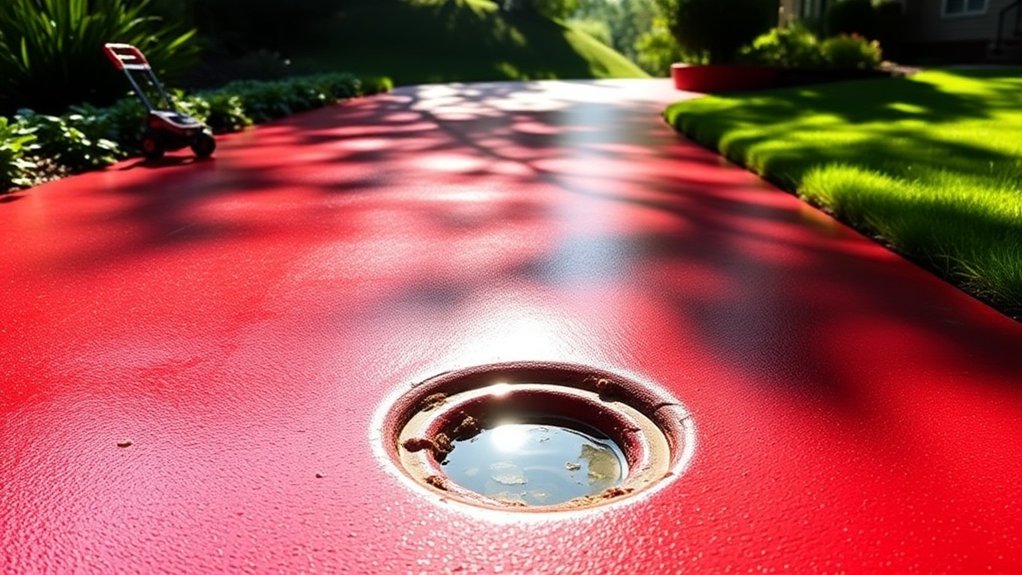
Drainage issues on your resin driveway can arise from a few common causes. Poor slope design, insufficient sub-base material, and clogged surface pores can all obstruct proper water runoff. For instance, if the driveway isn’t sloped correctly, water may pool rather than drain away, leading to potential damage. It’s crucial to tackle these problems quickly to preserve the durability and functionality of your driveway, as proper installation is crucial to avoid drainage problems. Additionally, understanding the importance of permeable driveways can provide insights into effective stormwater management solutions.
Improper Slope Design
Improper slope design can significantly affect the drainage efficiency of your resin driveway, leading to water pooling and potential damage.
To ensure effective water runoff, aim for a minimum slope of 1% to 2%. If the slope is too shallow, water won’t flow properly; if it’s too steep, you risk erosion and damage to the resin. Additionally, proper drainage is essential to prevent water pooling and runoff issues, which can exacerbate drainage problems. Implementing Sustainable Drainage Systems (SuDS) can enhance natural water absorption and flood prevention.
It’s crucial to implement proper slope adjustments and drainage strategies. Without well-placed drainage channels, surface water can accumulate, saturating the substrate.
Also, take into account the natural contours of the surrounding landscape to avoid trapping water.
If your driveway was poorly installed due to substandard workmanship or adverse weather, it’s important to address these issues as soon as possible.
A professional assessment can help you optimise your slope design, ensuring effective drainage and prolonging the life of your resin driveway.
Inadequate Sub-Base Material
A well-prepared sub-base is crucial for ensuring effective drainage and structural stability for your resin driveway.
Using inadequate materials, such as organic matter or non-porous aggregates, can obstruct water flow and cause substrate movement, leading to cracking and uneven surfaces over time.
For optimal stability, use MOT Type 3 aggregate, which is known for its permeability and load-bearing capacity.
Make sure to compact each layer properly, aiming for a thickness of 100mm to 250mm, depending on your soil conditions and anticipated loads.
Always keep the sub-base clear of vegetation and debris to avoid future problems.
A solid foundation not only enhances drainage but also extends the lifespan of your resin driveway.
Clogged Surface Pores
Even with a solid sub-base, drainage issues can still occur due to clogged surface pores on your resin driveway.
To effectively tackle this, consider the following:
- Accumulation of Dirt and Debris: Regularly sweep away leaves, dust, and organic matter. This prevents blockages and helps maintain permeability.
- Growth of Moss and Algae: Remove moss or algae promptly to prevent them from sealing the pores and hindering drainage.
- Staining from Contaminants: Clean up spills, such as oil or tree sap, straight away using mild detergents to keep the resin in good condition.
Signs of Poor Drainage to Watch For
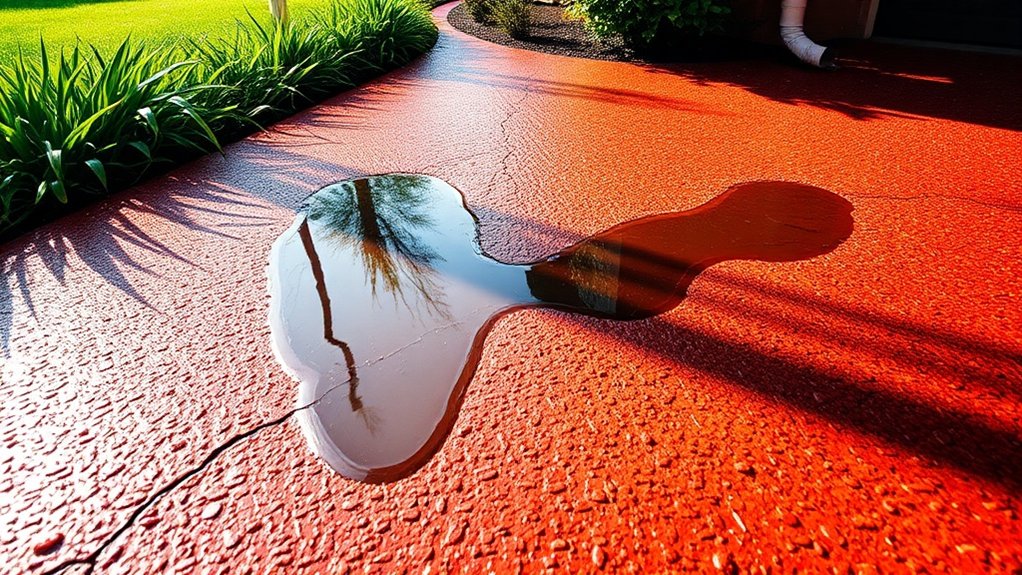
While enjoying the look of your resin driveway, it’s crucial to watch for signs of poor drainage that could lead to serious long-term problems.
Be on the lookout for pooling, like persistent puddles after rain, which indicate inadequate drainage and can weaken the driveway’s base.
Also, keep an eye out for discolouration; stains can show where water collects, impacting both appearance and strength.
Cracks and uneven surfaces are further warning signs, suggesting moisture is getting underneath the resin layer and causing erosion.
Tackling these issues early can help avoid costly repairs and keep your driveway looking great and functioning well for years to come.
Designing Your Driveway for Optimal Water Flow
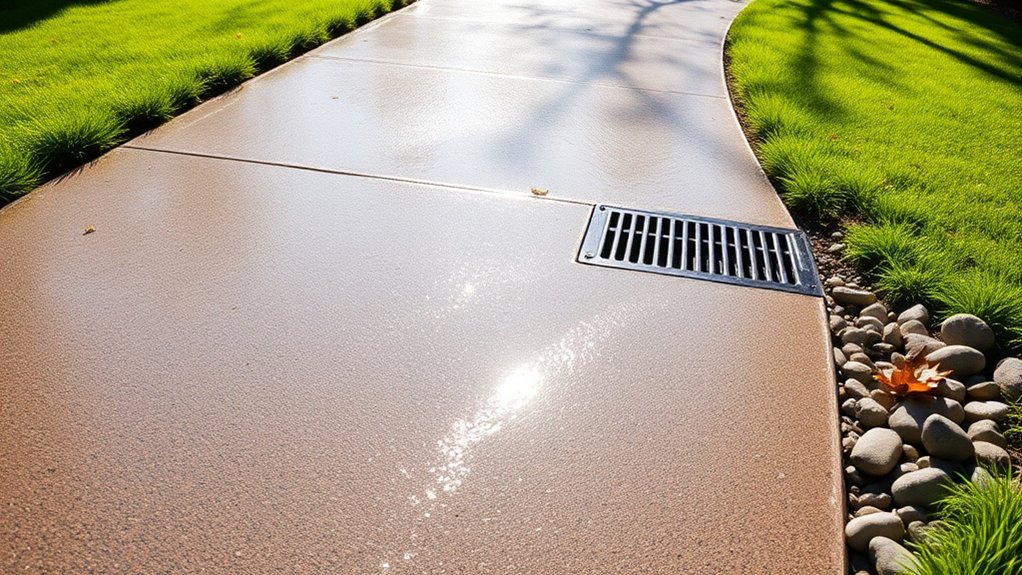
To ensure your resin driveway manages water flow effectively, consider the following design aspects from the beginning:
- Slope and Gradient: Aim for a minimum slope of 1% to direct water away from the driveway. This prevents pooling and protects your home’s foundation.
- Permeable Surface: Opt for resin bound aggregates to create a permeable surface that meets Sustainable Urban Drainage Systems (SuDS) standards. This not only looks good but also enhances functionality.
- Drainage Systems: Incorporate drainage channels at the lowest points to capture runoff, ensuring water is efficiently diverted away from the driveway.
Choosing the Right Sub-Base Material
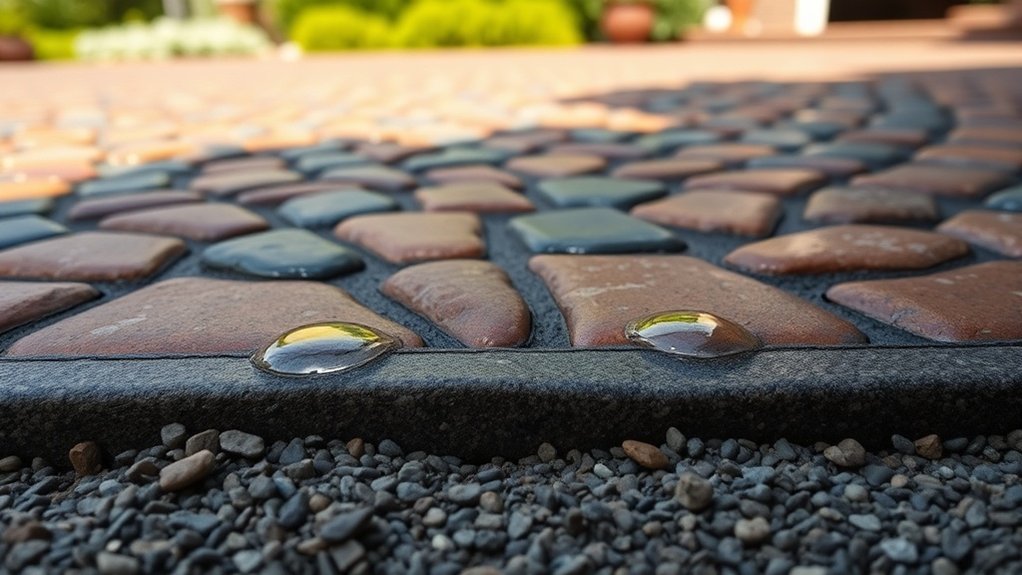
Choosing the right sub-base material is crucial for ensuring your resin driveway performs optimally and doesn’t suffer from drainage problems. Comparing sub-base materials helps you understand their properties and how they affect performance. For permeable needs, consider MOT Type 3, while MOT Type 1 is ideal for strength on slopes. Concrete is durable, but it requires effective drainage solutions.
| Material | Advantages | Disadvantages |
|---|---|---|
| MOT Type 1 | Strong, suitable for slopes | Less permeable |
| MOT Type 3 | Permeable, enhances drainage | Needs careful compaction |
| Concrete | Durable, stable | Impermeable, requires drainage |
Making the right choice now can prevent issues later and ensure the longevity of your driveway. Always aim for balanced compaction to achieve effective drainage!
The Role of Aggregate Selection in Drainage

Aggregate selection is crucial for effective drainage in your resin driveway, as the type and characteristics of the aggregates affect water flow and surface stability.
To enhance drainage, consider the following:
- Aggregate Size: Opt for a mix of 1-3mm and 2-5mm aggregates. The smaller sizes fill gaps, improving stability while ensuring adequate porosity.
- Aggregate Shape: Choose angular aggregates for better drainage, as they create more voids. Just ensure they bond well with the resin to keep the structure intact.
- Texture and Resistance: Select aggregates with high abrasion resistance to prevent clogging and maintain drainage efficiency over time.
Maintenance Tips for Preventing Drainage Issues
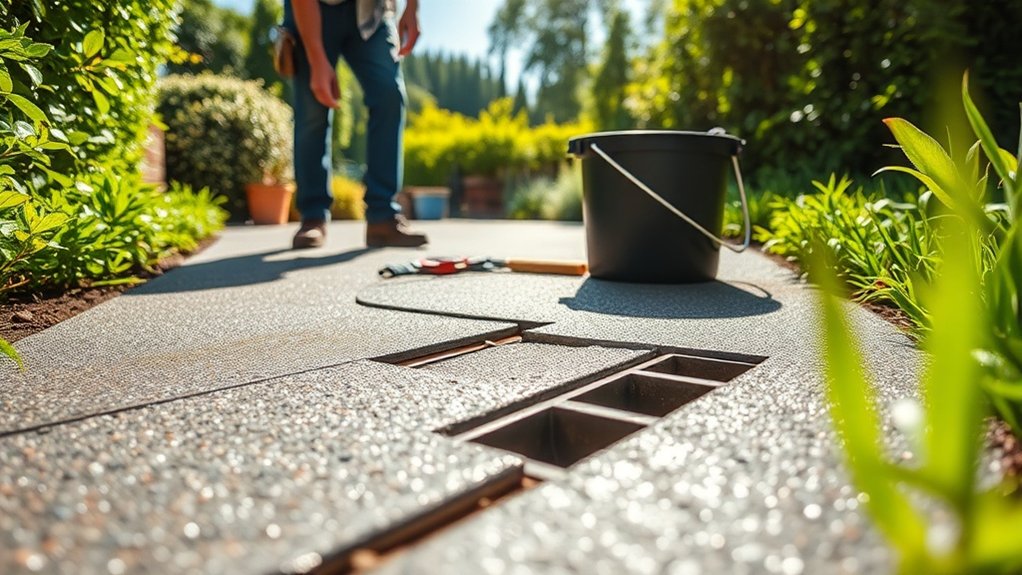
To keep your resin driveway in top condition and prevent drainage problems, it’s important to take some proactive steps.
Start with a weekly sweep to clear away dirt and debris that could clog the pores. A monthly hosing down will help control algae and moss, ensuring your driveway remains permeable. When cleaning, use water sparingly to protect the resin, and rinse thoroughly to avoid residue.
Don’t forget to tackle weeds promptly—either pull them out by hand or use a diluted weed killer when necessary.
Reseal your driveway every 1-2 years with UV-resistant products to prevent erosion. Regularly check for cracks and repair them with suitable kits to maintain drainage efficiency.
Following these tips will help keep your driveway functional and looking great.
Implementing Effective Drainage Solutions
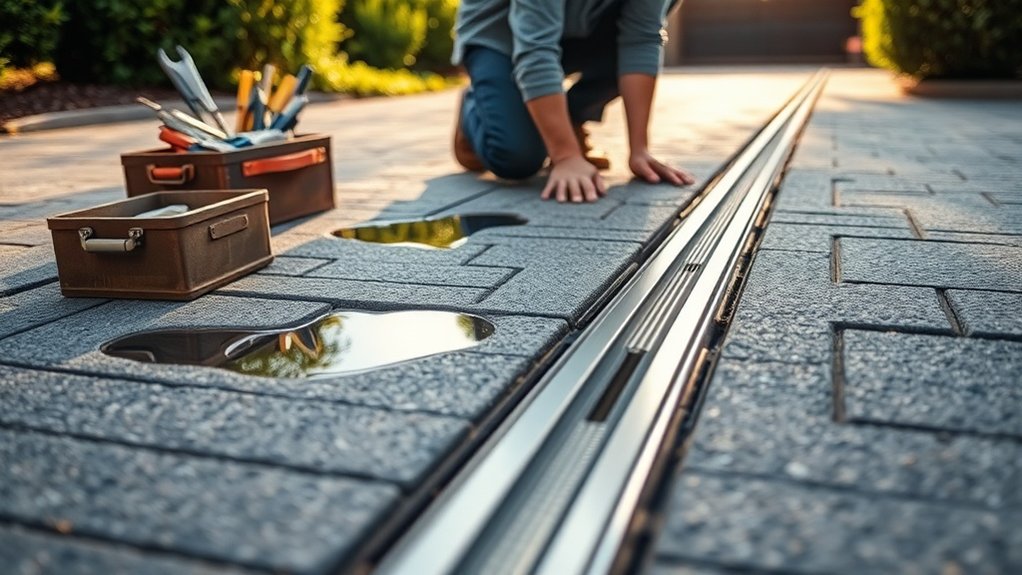
To effectively manage water flow on your resin driveway, prioritise the design of the driveway gradient and the choice of a permeable sub-base.
A well-designed gradient directs runoff away from your home, while selecting the right sub-base materials ensures efficient drainage through the surface.
Driveway Gradient Design
When designing a driveway gradient for effective drainage, it’s crucial to ensure the slope is between 1:12 and 1:40. This range helps prevent water pooling and increases safety.
Here are some key points to consider:
- Slope Measurements: Your gradient should guide water towards drains or soakaways.
- Avoid Flat Spots: Stay clear of any level areas where water can gather, as this can lead to erosion and damage.
- Robust Sub-Base: Incorporate proper drainage solutions beneath the surface to avoid water build-up.
Permeable Sub-Base Selection
Selecting the right permeable sub-base for your resin driveway is crucial for effective drainage and durability. Use open-graded aggregates, like open course macadam, to enhance water infiltration and ensure efficient drainage beneath the resin layer.
A well-compacted MOT Type 3 sub-base provides structural stability while allowing water to flow through. Consider polymer-enhanced options, such as Romex Trass Bed, which offer strength and permeability without the need for rebar.
Typically, a sub-base thickness of around 100mm is recommended, but adjust based on load and drainage needs. By choosing appropriate permeable materials and following Sustainable Urban Drainage System (SuDS) guidelines, you can reduce flooding risks and prolong the life of your resin driveway.
Ensuring Compliance With SUDS Regulations
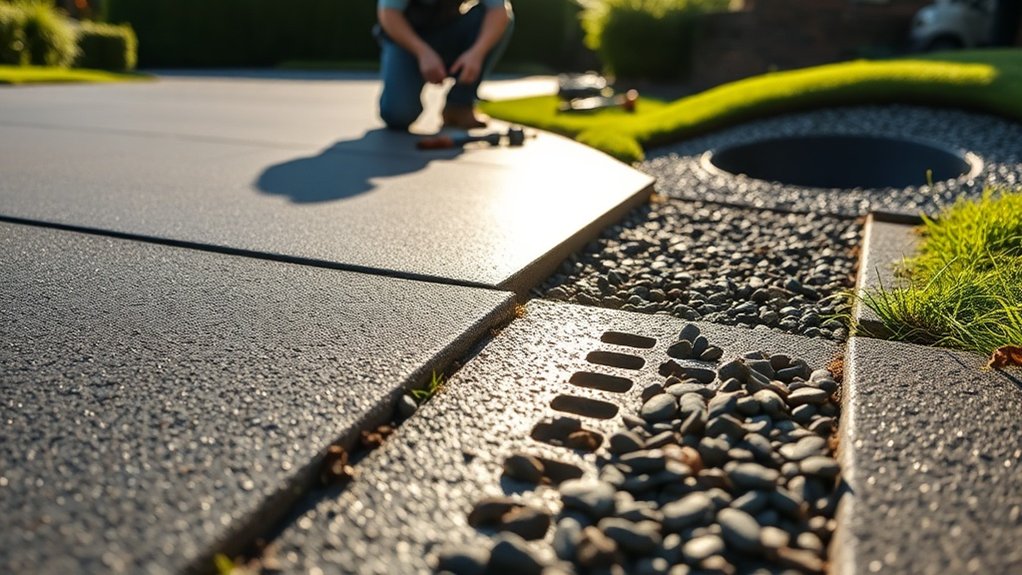
Ensuring compliance with SuDS regulations is crucial for any development looking to tackle drainage issues effectively. Here are some essential points to consider:
- Approval Process: Obtain approval for your drainage plans from the SuDS Approval Body (SAB), especially if your project involves multiple properties or affects local drainage.
- Runoff Hierarchy: Adhere to the runoff hierarchy by prioritising methods such as non-potable water use and infiltration. This helps reduce environmental impact and ensures you meet drainage requirements.
- Performance Standards: Design your system to manage the first 5mm of rainfall on-site. This controls discharge rates and prepares your development for extreme weather events.
Long-Term Benefits of Proper Drainage Management
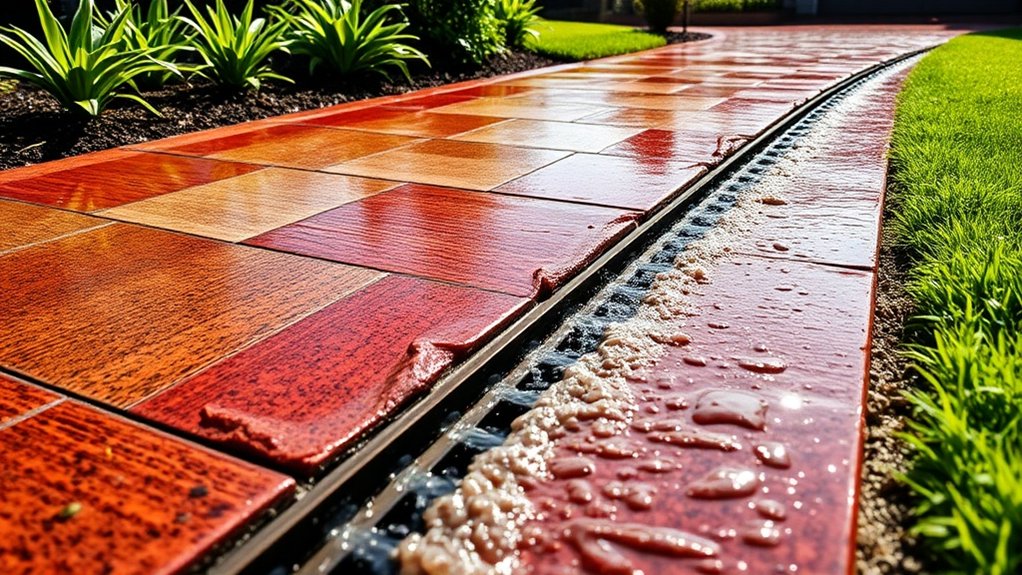
Effective drainage management not only protects your resin driveway but also offers substantial long-term benefits for the environment and your wallet.
By allowing rainwater to infiltrate naturally, you help harvest rainwater, which can reduce stormwater runoff and the risk of local flooding. This process also enhances water quality, benefiting nearby rivers and streams while supporting sustainable gardening practices.
Additionally, resin driveways are durable, meaning fewer repairs and lower maintenance costs over time.
With less need for harmful chemicals, you contribute to a healthier environment.
In the end, good drainage management not only extends the life of your driveway but also strengthens community resilience against climate challenges, promoting sustainable urban development and decreasing your overall environmental impact.
Frequently Asked Questions
Can I Install Resin Driveways Over Existing Concrete Surfaces?
Yes, you can install resin driveways over existing concrete surfaces. It’s important to properly prepare the concrete first. This includes cleaning it thoroughly, repairing any cracks, and applying a primer. Doing this will ensure a strong bond and extend the life of your resin driveway.
How Often Should I Reseal My Resin Driveway?
If your neighbour reseals their driveway every two years, you should consider doing the same. Regular maintenance protects against UV damage and wear, helping to keep your surface vibrant and durable over time.
What Is the Typical Lifespan of a Resin Driveway?
A resin driveway usually lasts between 15 to 25 years, depending on the quality of the resin and how well it’s maintained. To ensure it lasts as long as possible, it’s important to reseal it every 3 to 5 years and address any repairs promptly. This way, you can enjoy a durable and attractive driveway for years to come.
Are Resin-Bound Driveways Suitable for Heavy Vehicles?
Resin-bound driveways are suitable for regular family cars, but it’s important to consider their weight limits for heavier vehicles. For heavy vehicles, a proper installation and a robust sub-base are crucial to ensure durability and prevent damage. For instance, if you regularly park a large van or a 4×4, make sure your driveway is specifically designed to handle that weight.
Can I Customize the Color of My Resin Driveway?
Yes, you can customise the colour of your resin driveway with a range of colour options and design patterns. By mixing pigments and aggregates, you can achieve a unique appearance that enhances your home’s architectural style. For example, if you have a red brick house, a warm beige or grey resin could complement it nicely.
Conclusion
In the world of resin driveways, effective drainage is crucial for maintaining your surface, much like roots support a tree. By addressing drainage issues early and carefully planning your driveway, you can ensure a long-lasting and attractive finish. Regular maintenance and adhering to local regulations will keep your driveway in good condition and safe. Invest in proper drainage solutions today to prevent water-related problems and enjoy a driveway that remains in top shape.
Achieve a durable and slip-resistant tarmac driveway on slopes with expert installation tips and essential drainage solutions that will enhance Read more
Optimize your tarmac driveway's drainage to prevent costly water damage; discover essential strategies that can protect your investment and enhance Read more
Not sure how much a resin driveway will cost in 2025? Discover the key factors influencing pricing and installation that Read more

